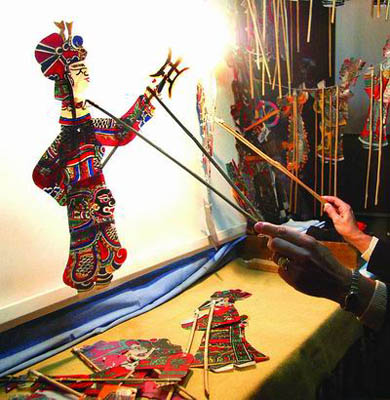In the book An Account of the Capital's Wonders, under the entry of "Miscellaneous Handicrafts," a few words say: "There is a kind of hand-operating shadow play."
According to Former Events in Wulin, "A sort of show staged in a small theater, and played by artists, is known as 'the great shadow show,' which is usually welcomed by children and its performance continues without stop in the whole evening."
In the musical score of the southern type ofquyi(a type of verse for singing), there was also a melody to accompany the performance of a "great shadow show."
 The Chinese character "qiao" meant the word "disguise" at the time. Various art performances in the then entertainment centers included a sort of qiaoxiangpu, or a comic wrestling.
The Chinese character "qiao" meant the word "disguise" at the time. Various art performances in the then entertainment centers included a sort of qiaoxiangpu, or a comic wrestling.
In the qiaoying show, actors would imitate some movements of figures in shadow show. They would perform a burlesque to raise a laugh among the audience. If shadow play at the time had not been so popular in society, the qiaoying show would have never emerged.
"Hand shadow show," taken literally, probably means to use hands to make various silhouette shapes on a screen, just like a game played by people of today using their hands to make various animal shapes before a light source to form silhouettes on a white wall. Or maybe it is just a small-scale shadow show with both hands.
The "great shadow show" has been specified as a show played by artists. In the light of the historical records, we may guess and imagine the situation of how some types of dramas in the Song and Yuan dynasties took in nourishment from the movements and music of puppet and shadow shows.
The rulers of theYuan Dynastytook shadow show as a pastime in their Imperial Court and military barracks. The army ofGenghis Khanmade a vast expedition across the expansive Euro-Asian continent. Along with the expedition, Chinese shadow show was also brought to many Arabic countries in the Persian Gulf area. And later it was brought into Turkey as well as to many countries in Southeast Asia.
In the early 14th century, the Persian historian Rashideg, telling an interesting episode in the history of exchange of shadow shows between China and Persia, said, "When the son of Genghis Khan came to the throne, he dispatched actors and artists to Persia to teach them a kind of drama played behind a screen (shadow show)."
